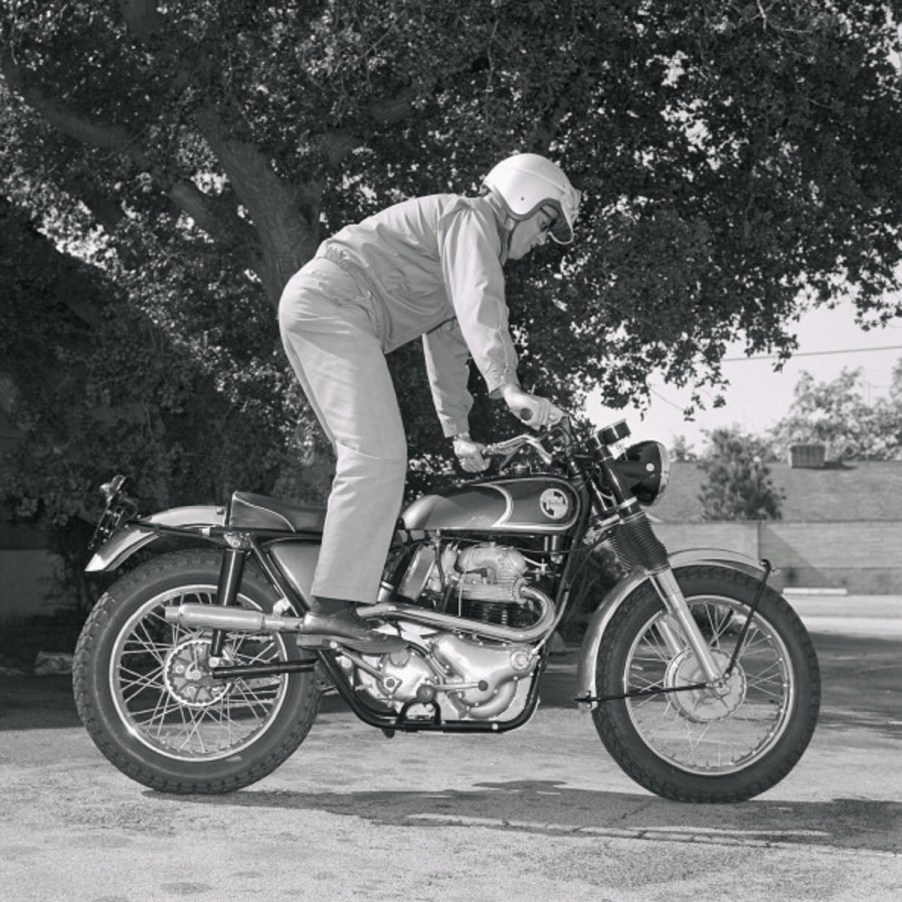
Does a Motorcycle Kickstarter Work Like an Electric Starter Motor?
If you plan on riding a classic motorcycle, you’ll naturally notice several differences compared to a modern bike. Carburetors instead of fuel injectors, for example, and fewer electronics. And depending on how old the motorcycle is, it may have a kickstarter instead of an electric starter. So, how does it work—and is it worth keeping on?
What are the differences between using a motorcycle kickstarter and a ‘conventional’ starter motor?
Whether your motorcycle has a kickstarter or a starter motor (what we usually just call a ‘starter’), they serve the same basic function. That function being getting the bike’s engine fired up. And interestingly, on a basic level, a kickstarter and a starter motor work fairly similarly.
Unlike some cars, motorcycles don’t start with a twist of a key. But just like in a car, turning a bike’s key primes the ignition system by connecting electrical terminals. And if you have keyless ignition, as some motorcycles now do, the ignition hooks up when the key is nearby. The real starting process begins when you press the start button, just as with a push-button car.
Pushing the button does two things. First, it sends power to the spark plugs so they can fire, Haynes explains. Then, a magnetic switch connects the starter motor to the bike’s battery. The starter motor is connected by a gear to the engine’s flywheel. The flywheel turns which turns the crankshaft and the pistons. Simultaneously, the plugs spark, and the fuel in the combustion chamber burns, Autoblog explains. Voila, the motorcycle’s engine starts.

Modern bike ignition systems are noticeably less complicated, parts-wise, than vintage ones, Cycle World reports. But fundamentally, a motorcycle kickstarter works the same way as a modern starter motor, RideApart explains.
Admittedly, some kickstarters hook up to the transmission main shaft, rather than the flywheel, NADAGuides reports. However, a motorcycle kickstarter still turns gears to turn the engine over, like the hand-crank on a Model T. Though it requires a bit more work on the rider’s part.
How to use a kickstarter
Before you use a motorcycle kickstarter, you have to prepare some good starting conditions, RideApart explains. If you have carburetors, you have to prime the engine. That’s done by engaging the choke and kicking the engine over a few times with the throttle open and the ignition off.
Some motorcycles with kickstarters also come with compression release levers. Combustion engines work by compressing fuel and air, but compressing air is hard work. The release lever makes it easier for the rider to work the motorcycle kickstarter by lowering the compression. It also helps prevent the starter lever from kicking back and whacking the rider’s leg.

Next, make sure the engine is at top-dead-center. This is when the piston is at the very top of its travel. Some bikes have indicator windows to let you know when you’re at TDC. Finally, turn the ignition on and firmly kick down on the motorcycle kickstarter level using your weight to start the bike.
Do any motorcycles still have a kickstarter?

The first motorcycles didn’t even have kickstarters; instead, you started them by pedaling them or via push-start. But they were standard equipment on many bikes even after the Honda CB750 offered a standard electric starter motor at an affordable price. The contemporary Velocette Venom, for example, was always kickstart-only. However, today they’re mostly only found on dirt bikes or other off-road machines. And even there they’re starting to disappear, RevZilla reports.
That’s not to say there haven’t been a few modern kickstarter hold-outs and throwbacks. The previous-gen Royal Enfield Continental GT, for example, had both a kickstarter and an electric starter motor. And the current Honda Trail 125 has both as well, Cycle World reports. But why has it lasted this long?
Initially, the kickstarter was the most reliable way of getting your motorcycle started, RevZilla reports. And many early electric starter motors were bulky, heavy, and often fairly weak. The one on the Norton Commando couldn’t even start the engine on its own. But as the starter motors got stronger, lighter, smaller, and more reliable, the kickstarter became unnecessary. The Honda Trail 125 retains it for nostalgia points and as a mechanical back-up in case the conventional starter breaks.
Sophisticated electronics, then, have replaced muscle effort. And in many ways, that makes it easier for smaller and lighter riders to enjoy bikes.
Follow more updates from MotorBiscuit on our Facebook page.


